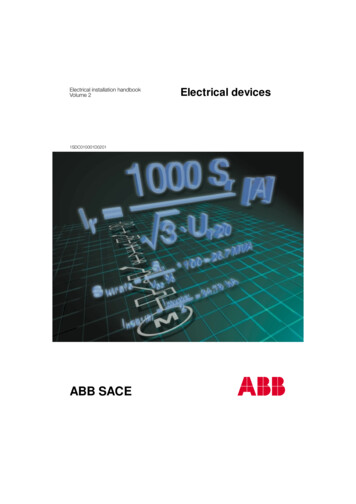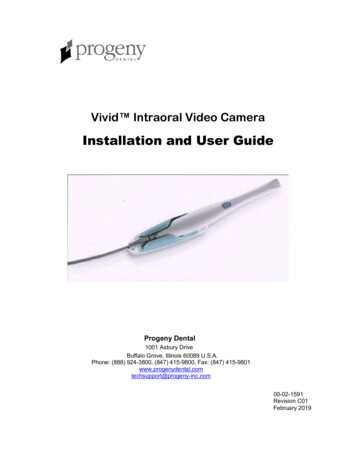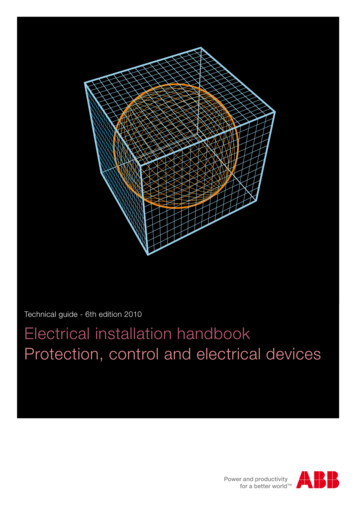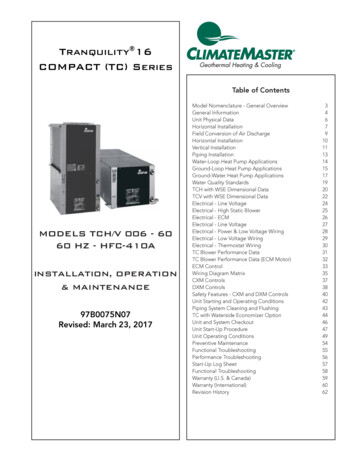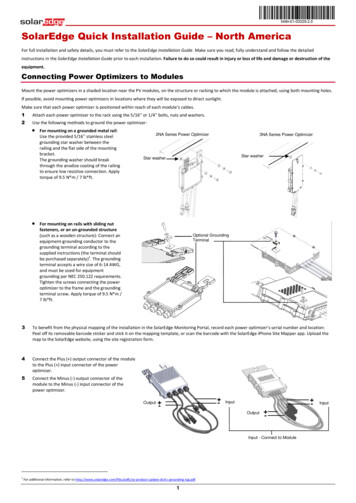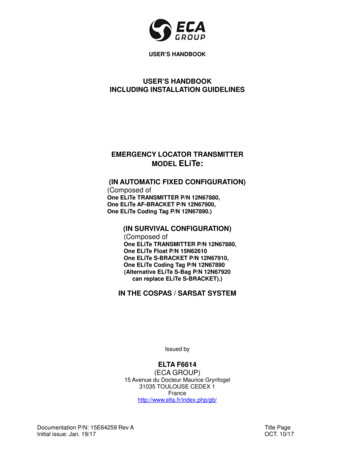
Transcription
USER’S HANDBOOKUSER’S HANDBOOKINCLUDING INSTALLATION GUIDELINESEMERGENCY LOCATOR TRANSMITTERMODEL ELiTe:(IN AUTOMATIC FIXED CONFIGURATION)(Composed ofOne ELiTe TRANSMITTER P/N 12N67880,One ELiTe AF-BRACKET P/N 12N67900,One ELiTe Coding Tag P/N 12N67890.)(IN SURVIVAL CONFIGURATION)(Composed ofOne ELiTe TRANSMITTER P/N 12N67880,One ELiTe Float P/N 15N62610One ELiTe S-BRACKET P/N 12N67910,One ELiTe Coding Tag P/N 12N67890(Alternative ELiTe S-Bag P/N 12N67920can replace ELiTe S-BRACKET).)IN THE COSPAS / SARSAT SYSTEMIssued byELTA F6614(ECA GROUP)15 Avenue du Docteur Maurice Grynfogel31035 TOULOUSE CEDEX on P/N: 15E64259 Rev AInitial issue: Jan. 19/17Title PageOCT. 10/17
PAGE INTENTIONALLY LEFT BLANK
LIST OF UPDATESUPDATE No.INSERTIONISSUEPreliminaryDATEJanuary19/17BYC. CRESPA –Draft0 June 22/17C. CRESPA –Draft1 July 12/17C. CRESPA –Draft2 Aug. 08/17C. CRESPOct. 10/17C. CRESPA - FinalDocumentation P/N: 15E64259 Rev AUPDATENo.INSERTIONISSUEDATEBYPage 1Oct. 10/17
PAGE INTENTIONALLY LEFT BLANKPage 2BLANK
LIST OF EFFECTIVE PAGESCHAPTER/SECTIONTITLE PAGELISTE OF UPDATESDATEPAGEOCT. 10/17BLANKLIST OF EFFECTIVE PAGE34OCT. 10/17BLANKTABLE OF ILLUSTRATIONS56OCT. 10/17BLANKLEADING PARTICULARS78OCT. 10/17BLANKTABLE OF 031323334OCT. 10/17BLANKOCT. 10/17OCT. 10/17OCT. 10/17OCT. 10/17OCT. 10/17OCT. 10/17OCT. 10/17OCT. 10/17OCT. 10/17OCT. 10/17OCT. 10/17OCT. 10/17OCT. 10/17OCT. 10/17OCT. 10/17OCT. 10/17OCT. 10/17OCT. 10/17OCT. 10/17OCT. 10/17OCT. 10/17OCT. 10/17OCT. 10/17OCT. 10/17GENERAL DETAILS OFTHE ELiTe ELTDESCRIPTION OF THEELiTe ELT AND OF THE AI.INSTALLATION OF THEELiTe 555657585960616263646566OCT. 10/17OCT. 10/17OCT. 10/17OCT. 10/17OCT. 10/17OCT. 10/17OCT. 10/17OCT. 10/17OCT. 10/17OCT. 10/17OCT. 10/17OCT. 10/17OCT. 10/17OCT. 10/17OCT. 10/17OCT. 10/17OCT. 10/17OCT. 10/17OCT. 10/17OCT. 10/17OCT. 10/17OCT. 10/17OCT. 10/17OCT. 10/17OCT. 10/17OCT. 10/17OCT. 10/17OCT. 10/17OCT. 10/17OCT. 10/17OCT. 10/17OCT. 10/17APPENDIX A1 to 6OCT. 10/17APPENDIX B1 to 12OCT. 10/17APPENDIX C1 to 4OCT. 10/17APPENDIX D1 to 2OCT. 10/17OCT. 10/1712INTRODUCTION OF THE C.CHAPTER/SECTIONDocumentation P/N: 15E64259 Rev AINSTALLATION OF THEELiTe SUTILIZATIONMAINTENANCEGLOSSARYELiTe ELT Automatic FixedELiTe ELT Survival S-BRA.ELiTe ELT Survival S-BagPage 3Oct. 10/17
PAGE INTENTIONALLY LEFT BLANKPage 4BLANK
TABLE OF ILLUSTRATIONSFigure 1 COSPAS/SARSAT – System Principle. 12Figure 2 ELiTe Automatic Fixed (AF) – Presentation . 16Figure 3 ELiTe Automatic Fixed - Sub Components . 17Figure 4 Survival – ELiTe S-BRACKET Sub Components . 19Figure 5 Survival – ELiTe S-Bag Sub Components. 20Figure 6 ELiTe Automatic Fixed (AF) Configuration - Overall Dimensions . 21Figure 7 ELiTe Survival Configuration - Overall Dimensions . 22Figure 8 ELiTe Survival (Bag) – Alternative Solution – Overall Dimensions. 23Figure 9 ELiTe TRANSMITTER - Labels. 31Figure 10 ELiTe AF-BRACKET – Labels . 32Figure 11 Tolerances on the Axis for Installation of the ELiTe ELT (AF) . 35Figure 12 Automatic activation direction selection for ELiTe Automatic Fixed configuration . 35Figure 13 Installation of the ELT ELiTe ELT AF (Automatic Fixed configuration) - Drilling Pattern Dimensions. 36Figure 14 ELITE Beacon Installation – Wiring Diagram . 38Figure 15 ELiTe Float Installation Process . 40Figure 16 ELiTe TRANSMITTER equipped with ELiTe Float . 41Figure 17 Installation of the ELiTe ELT S (Survival configuration) Drilling Pattern Dimensions . 42Figure 18 ELiTe Survival - Recommended Configuration . 42Figure 19 ELiTe Survival - Alternative Configuration . 43Figure 20 ELT ELITE – Automatic Fixed – Detailed Description . 64Figure 21 ELT ELITE – Survival with ELiTe S-BRACKET– Detailed Description . 65Figure 22 ELT ELITE – Survival with ELiTe S-Bag– Detailed Description . 66Page 5Oct. 10/17
PAGE INTENTIONALLY LEFT BLANKPage 6BLANK
LEADING PARTICULARSCAUTION 1 : THIS TRANSMITTER IS AUTHORIZED FOR USE ONLY DURING SITUATIONS OF GRAVEAND IMMINENT DANGER.CAUTION 2 : IT IS IMPERATIVE THAT EACH ELT OWNER REGISTERS THEIR ELT (COSPAS-SARSATIDENTIFICATION CONTAINED IN ELITE CODING TAG). CONTACT THE LOCALAIRWORTHINESS OR ELTA OR APPROVED ELTA AGENT TO OBTAIN THE INFORMATIONRELATIVE TO THIS REGISTRATION AS NECESSARY.NOTE: Guidelines can be found on the Cospas-Sarsat website (www.cospas-sarssat.org – C/S S.007 Handbookof regulations on 406 MHz and 121.5 MHz beacons).CAUTION 3 : THE ELITE CODING TAG MUST IMPERATIVELY BE PROGRAMMED WITH THE RELEVANTCOSPAS-SARSAT IDENTIFICATION AUTHORIZED BY THE LOCAL AIRWORTHINESS.CAUTION 4 : ONCE THE ELITE CODING TAG HAS BEEN PROGRAMMED, IT IS GENERALY ASSIGNEDTO AN AIRCRAFT (NAME AND IDENTIFICATION). IF THIS ELITE CODING TAG ISTRANSFERRED TO ON ANOTHER AIRCRAFT OR OPERATOR IT MUST BEREPROGRAMMED (NEW NAME AND IDENTIFICATION).CAUTION 5 : BEFORE INSTALLING OR USING THIS ELT, THE VALIDITY OF THE INFORMATION ONELITE TRANSMITTER LABELS MUST IMPERATIVELY BE CHECKED (BATTERY EXPIRY,COSPAS-SARSAT IDENTIFICATION AS A MINIMUM).CAUTION 6 : ELITE TRANSMITTER WILL GET AUTOMATICALLY ITS COSPAS-SARSAT IDENTIFICATIONFROM ELITE CODING TAG WHEN INSTALLED ON ANY BRACKET OR BAG.CAUTION 7 : ELITE TRANSMITTER READS ITS COSPAS-SARSAT IDENTIFICATION FROM ELITECODING TAG AND STORES IT INTERNALLY NON VOLATILE MEMORY AT EACH SELFTEST OR ACTIVATION (MANUAL OR AUTOMATIC) REQUEST.CAUTION 8 : ELITE TRANSMITTER KEEPS ITS PREVIOUS COSPAS-SARSAT IDENTIFICATION WHENREMOVED FROM ANY BRACKET OR BAG. IT SHALL BE SWITCHED OFF PRIOR ANYTRANSPORTATION OR MAINTENANCE IN ORDER TO AVOID ANY FALSE ALERT.CAUTION 9 : IT IS ESSENTIAL TO ENSURE THE ELITE TRANSMITTER IS SUCCESSFULLY CODED ONINITIAL AND FURTHER INSTALLATIONS INTO THE AIRCRAFT PRIOR TO USE IT IN ORDERTO AVOID ANY FALSE ALERT BY USING INAPPROPRIATE CODE.NOTE: Upon removal ELiTe TRANSMITTER keeps its previous C/S coding (see CAUTION 8). Initial (first)delivery from ELTA is using a generic default code inappropriate for operational use.Documentation P/N: 15E64259 Rev APage 7Oct. 10/17
PAGE INTENTIONALLY LEFT BLANKDocumentation P/N: 15E64259 Rev APage 8BLANK
TABLE OF CONTENTSLIST OF UPDATESLIST OF EFFECTIVE PAGESTABLE OF ILLUSTRATIONSLEADING PARTICULARSTABLE OF CONTENTS1. INTRODUCTION TO THE COSPAS-SARSAT SYSTEMA. The COSPAS-SARSAT* systemB. System organization (Ref. Figure 1)C. ELTA and the COSPAS-SARSAT system2. GENERAL DETAILS OF THE ELITE ELTA. Purpose of the ELiTe ELT (Ref. Fig. 2)B. ELiTe ELT principleC. ELiTe ELT ConfigurationsD. ELiTe installed overall dimensionsE. Characteristics (Ref. Fig. 3)3. DESCRIPTION OF THE ELITE ELT AND OF THE AIRCRAFT COMPONENTSA. General descriptionB. Detailed description4. INSTALLATION OF THE ELITE AUTOMATIC FIXED CONFIGURATIONA. GeneralB. Installation of ELiTe (AF) on the aircraft (Ref. Figure 11)C. External antenna installationD. Remote Control Panel installationE. ELiTe peripherals connection diagramF. Installation and configuration of the ELiTe Automatic Fixed (Ref. Figure 14)5. INSTALLATION OF THE ELITE SURVIVAL CONFIGURATIONA. GeneralB. Installation of ELiTe (S) on the aircraft.6. UTILIZATION OF THE ELITE ELT (REF. FIGURE 20)A. GeneralB. Typical Operational scenariosC. Automatic activationD. Manual activationsE. Restoring ELiTe TRANSMITTER in ARMED (standby)F. Beacon self-testG. Switching ARMED automatically the ELiTe TRANSMITTERH. Switching ARMED Manually the ELiTe TRANSMITTERI. Switching OFF the ELiTe TRANSMITTER7. MAINTENANCE OF THE ELITE ELTA. Beacon self-testB. Maintenance periodicity tableC. Batteries replacement (ELiTe TRANSMITTER only)D. Batteries discardingE. Test to do at the time of a beacon return in workshopF. ELiTe Coding Tag access for ELiTe Cospas-Sarsat Identification update.8. GLOSSARYDocumentation P/N: 15E64259 Rev 40444444464648495656585959626262636363Page 9Oct. 10/17
PAGE INTENTIONALLY LEFT BLANKPage 10BLANK
1. INTRODUCTION TO THE COSPAS-SARSAT SYSTEMA. The COSPAS-SARSAT* systemThe purpose of the COSPAS-SARSAT satellite system is to detect and locate all distress signals transmittedby aeronautical, maritime or land-based beacons, for the search and rescue organizations.This program is the result of an international collaboration between the United States, Canada and Franceon the one hand (SARSAT project), and Russia on the other hand (COSPAS project). These two projectsare fully compatible.Since the first results were obtained several countries have joined the program. Other countries continue tojoin the COSPAS-SARSAT system partners.ELTA in relation with CNES (French National Space Agency) has developed the complete range of productsrequired for COSPAS-SARSAT system operation. Now ELTA is focusing in the design and production ofELT’.Following an in-depth study phase, ELTA has arrived at highly conclusive technical results. Experimental andoperational use of the "ground" equipment have proven this equipment's reliability and ease-of-use.At the end of 2015 the total estimated Cospas-Sarsat beacon is about 2,000,000.From 1982 (date of the official Cospas-Sarsat system entry to service) to end of 2015, at least 41,750persons have been saved thanks to Cospas-Sarsat use.B. System organization (Ref. Figure 1)In the COSPAS-SARSAT system, space equipment is placed on board several satellites in low near-polarorbit to capture transmissions from emergency transmitters and to retransmit these signals to specializedground stations called Local User Terminals (LUT). These ground stations determine the position of theemergency transmitters and then retransmit the position data to the designated Mission Control Centers(MCC). The MCCs in turn retransmit these data to the appropriate Rescue Coordination Centers (RCC) sothat they can start the search and rescue operations.Documentation P/N: 15E64259 Rev APage 11Oct. 10/17
Figure 1COSPAS/SARSAT – System Principle(courtesy of Cospas-Sarsat)COSPAS-SARSAT means:COSPAS Kosmicheskaya Sistyema Poiska Avariynych SudovSARSAT Search and Rescue Satellite-Aided TrackingDocumentation P/N: 15E64259 Rev APage 12Oct. 10/17
There are several advantages to using the 406 MHz frequency:–Worldwide coverage: locating is not only possible in real-time within a radius of 2,500 km around thestation, but also in global mode outside this zone since the satellites memorize the messages on the406 MHz frequency. Location process uses Doppler effect.–Locating accuracy: 2 km as opposed to 10 to 15 km in the 121.5 MHz frequency. It should be notedhowever that the 406 MHz beacons also transmit 121.5 MHz signal which enable the final approach ofthe rescue teams in homing mode.–Information reliability: the structure of the digital signal transmitted by these beacons makes it possibleto be sure that there is actually a distress situation, as well as to identify automatically the mobile indistress which is vital for rescue operations.–Unique identification: each beacon has it’s own identification information.–Possibility to incorporate local Position data (GNSS) in the 406 MHz transmitted messageC. ELTA and the COSPAS-SARSAT system(1) 406 MHz distress beacons:These beacons transmit to the satellites a digital message which identifies them and gives their position,as well as a signal that facilitates the final approach of the rescue teams.They are suitable for all types of use (maritime, aeronautical and land) and can, depending on the model,be activated manually or automatically. They are designed to function in the most extreme conditions witha high degree of reliability.(2) Low earth orbiting satellites:At least four satellites are permanently operational. Since their orbit is near-polar, in the worst case everypoint on Earth is overflown every two hours.In a ground station's visibility zone, the satellites directly transmit the messages captured in that zone,and also any messages from the zones not covered that they have stored in memory.(3) Geo-stationary satellites are now available in the system and offer faster detection capability (close to 5minutes) but require a GPS receiver to supply location that is sent via C/S message.(4) Medium earth orbiting satellites:In a very near future, such satellites will be added to Cospas-Sarsat System. They will improve theCospas-Sarsat performances and will allow the introduction of second generation ELT. They are not yetoperational.(5)Ground reception stations:The zone effectively covered (or visibility zone) is a circle with a radius of 2,500 km around the station.These stations receive (via the satellites) and process: in real time, the messages from the beacons activated in their visibility zone and, in batch mode, the messages from the 406 MHz beacons activated outside that visibility zone andmemorized by the satellites.Automatic processing of the 406 MHz digital messages allows the beacons to be located and the mobilecarrier to be identified.Documentation P/N: 15E64259 Rev APage 13Oct. 10/17
2. GENERAL DETAILS OF THE ELiTe ELTA. Purpose of the ELiTe ELT (Ref. Fig. 2)With ELiTe ELT, ELTA proposes a new patented concept based on the supply of one unique Cospas-Sarsatdistress transmitter available for both Automatic Fixed and Survival ELT applications.The ELiTe ELT is designed to transmit a digital distress signal to satellites that are part of theCOSPAS/SARSAT SYSTEM.These satellites transmits the captured signal to the reception stations on the ground (LUT).This signal is transmitted on the 406.040 MHz frequency and is used to precisely locate and identify theELiTe ELT.It also transmits a 121.5 MHz signal to facilitate the final approach of the distress scene (final homing).This ELT meets the latest ICAO and EOPS recommendations. It is ETSO C126b, ETSO C142a approuved.Through the current EASA/FAA bilateral agreement it is automatically recognized as TSO C126b and TSOC42a.B. ELiTe ELT principleELiTe ELT principle is based on the association of the unique transmitter (ELiTe TRANSMITTER) anddedicated mounting brackets (ELiTe AF-BRACKET or ELiTe S-BRACKET, or alternative storage andtransportation bag ELiTe S-Bag). It is this association that offers the final ELT type i.e. Automatic Fixed (AF)or Survival (S).The purpose of the ELiTe Coding Tag is to store on board the A/C the Cospas-Sarsat identification.The Cospas-Sarsat Identification is memorized in an independent non-volatile memory located in thisdedicated passive wireless radio frequency device (very short range RFID technology).This part is located on the ELiTe AF-BRACKET, or in ELiTe S-BRACKET or in ELiTe S-Bag, the alternativestorage and transportation bag of ELiTe S-BRACKET.This part can be attached to the A/C structure by the mean of a metallic strap, when required.It will keep, on board the A/C, the Cospas-Sarsat Identification code.Upon any type of activation (automatic of manual) or after each self-test, ELiTe TRANSMITTER is acquiringthis relevant Cospas-Sarsat Identification Code and will use it to transmit the correct distress signal on406.040 MHz.The operator is then sure that any new ELiTe TRANSMITTER installed on/in its relevant bracket will transmitthe correct Cospas-Sarsat message upon it’s activation.NOTE: Such wireless communication between ELiTe TRANSMITTER and ELiTe Coding Tag is a very shortrange one, only few mm avoiding any risk of duplication/error.NOTE: A copy of this Cospas-Sarsat ID code is made internally by ELiTe TRANSMITTER in non volatilememory at each self-test or activation request allowing correct transmission even when the transmitter isremoved from its bracket (case of the Survival configuration) or in case of ELiTe Coding Tag access failure(any type of ELiTe configuration).During self-test process, the transmitter indicates the presence or absence of a valid ELiTe Coding Tagcontent. Any change i.e. new ELiTe Coding Tag, (so new Cospas-Sarsat ID code) is detected.If the ELiTe Coding Tag is absent or damaged (after the first installation correct reading), the transmitter willuse its internal copy for Cospas-Sarsat identification for the distress transmission (backup mode).Documentation P/N: 15E64259 Rev APage 14Oct. 10/17
As a consequence when the transmitter is removed from its bracket it can transmit the relevant C/S ID (fromits internal backup memory).Transmission will be made with the “last acquired” ELiTe Coding Tag content.NOTE: When ELiTe TRANSMITTER is removed for maintenance or transportation it is important to put it inthe “OFF” mode avoiding any transmission (false alert possibility).Valid Cospas-Sarsat Identification is indicated on the ELiTe Coding Tag label and is also displayed on theELiTe TRANSMITTER LCD display at each self-test or activation.If the ELT ownership change, the ELiTe Coding Tag shall be re-coded in order to get a new unique 15 digitHex Code, with the appropriate new country code and new coding protocol as selected or required by thecountry of the new final operator. Contact ELTA for additional details (www.elta.fr ) as necessary.Coding of the ELiTe Coding Tag is realized using the dedicated ELiTe C/S ID ENCODER TOOLP/N 17N23476 (see CMM 25-60-17 for detail) constituted of a PC software and RFID tag reader/writer USBinterface.NOTE: In addition to the Cospas-Sarsat identification data, additional “configuration data” are stored insidethe nonvolatile memory of the ELiTe Coding Tag. As a consequence an ELiTe Coding Tag encoded for andAutomatic Fixed configuration shall not be used for Survival configuration and vice versa.These “configuration data” are factory set at ELTA and cannot be modified by the dedicatedELiTe C/S ID ENCODER TOOL P/N 17N23476 avoiding any wrong use of the intended ELiTe ELT(Automatic Fixed or Survival).C. ELiTe ELT Configurations(1) ELiTe ELT in the AUTOMATIC FIXED CONFIGURATIONIn this configuration, ELiTe is an Automatic Fixed Emergency Locator Transmitter (ELT) distress beacon.ELiTe TRANSMITTER can be removed (example for maintenance) and ELiTe AF-BRACKET remainsinstalled and connected onboard the A/C (reliability improvement).ELiTe TRANSMITTER gets the relevant COSPAS-SARSAT Identification from ELiTe Coding Tag located onELiTe AF-BRACKET.In this Automatic Fixed (AF) configuration, It can be triggered manually (either from remote control panellocated in the cockpit or from ELiTe TRANSMITTER keypad) or automatically by means of an accelerationsensor (G-switch, located on ELiTe AF-BRACKET) in accordance to EUROCAE ED-62A / RTCA DO-204Astandards.Any encoding User, User Location and Standard Location protocols defined by Cospas/Sarsat can be usedin this configuration including country code assignation.When ELiTe AF-BRACKET is connected to A/C 28 Vdc and A/C ARINC 429 Data Bus, it can receive theA/C location (Latitude & Longitude). This information is then incorporated in the Cospas-Sarsat Identificationencoded as “Long”. Message location accuracy transmitted is truncated to 4’ of angle (about 5 Km) for UserLocation protocol or 4” of angle (about 500 m) for Standard Location protocol as specified by CospasSarsat).Basic User Protocols can be use with the Automatic Fixed configuration when there is no possibility to getaccess to location data from the A/C.Documentation P/N: 15E64259 Rev APage 15Oct. 10/17
ELiTe AF BRACKETP/N 12N67900ELiTe Coding TagP/N 12N67890, islocated onELiTe AF BRACKETunderELiTe TRANSMITTERELiTe TRANSMITTERP/N 12N67880Battery PackcompartmentFigure 2ELiTe Automatic Fixed (AF) – PresentationPhoto Not ContractualDocumentation P/N: 15E64259 Rev APage 16Oct. 10/17
Access toExternal Antenna (BNC)Automatic Activation module (G-Switch)CAUTION : THIS MODULE IS MANDATORY FORCORRECT AUTOMATIC FIXED OPERATIONS.Access toRemote Control Panel (RCP),A/C ARINC 429 Bus,A/C 28 VdcInternal 406 & 121.5 MHzantennaInternal GNSSdevice(receiver &antenna)White FlashLED (qty 2)ELiTe Coding Tag(Content C/S ID)CAUTION :THIS PART ISMANDATORYFOR CORRECTAUTOMATIC FIXEDOPERATIONS.ThreecoloredLEDDisplay andkeyboard controlsELiTe AF-BRACKETELiTe TRANSMITTERConnectorMetallicStrapBattery PackFigure 3ELiTe Automatic Fixed - Sub ComponentsPhoto Not ContractualDocumentation P/N: 15E64259 Rev APage 17Oct. 10/17
(2) ELiTe ELT in the SURVIVAL CONFIGURATIONIn Survival (S) configuration it can be triggered manually from ELiTe TRANSMITTER keypad in accordancewith EUROCAE ED-62A / RTCA DO-204A standards.In addition ELiTe ELT proposes another mean of activation using a water sensor located on ELiTeTRANSMITTER.NOTE: It is not considered as “Automatic activation” per ICAO standard.NOTE: This water sensor is inoperative in automatic fixed configurations.Any encoding User Location or Standard Location protocols defined by COSPAS/SARSAT (C/S) can beused in this configuration including country code assignation.NOTE: Basic User protocols cannot be used with the Survival configuration as it not type approved byCospas-Sarsat.Documentation P/N: 15E64259 Rev APage 18Oct. 10/17
(a) Standard solution using ELiTe S-BRACKETIn this configuration ELiTe is a Survival Emergency Locator Transmitter (ELT) distress beacon.ELiTe TRANSMITTER can be removed (example for maintenance) and ELiTe S-BRACKET remainsinstalled onboard the A/C. There is no connection/wiring with the A/C in this configuration.ELiTe TRANSMITTER gets the relevant COSPAS-SARSAT Identification from ELiTe Coding Tag stored andlocated in an internal foam of ELiTe S-BRACKET.ELiTe TRANSMITTER equipped with ELiTe Float shall be removed from ELiTe S-BRACKET for correctdistress signal transmission to Cospas-Sarsat satellite (not intended to remain in the bracket while activated)ELiTe S-BRACKET Closedas installed onboard A/C.ELiTe TRANSMITTERP/N 12N67880)(includes Water Sensorfor additionalActivation)NOTE: It is made of textile,so it is easy to verify ifELiTe TRANSMITTER ispresent or not inside (touch& visual inspection)ELiTe S-BRACKETP/N 12N67910ELiTe FloatP/N 15N62610Figure 4Survival – ELiTe S-BRACKET Sub ComponentsELiTe Coding TagP/N 12N67890(contains C/S ID)Islocated insideELiTe SBRACKETunderELiTe TRANSMITTERPhoto Not ContractualDocumentation P/N: 15E64259 Rev APage 19Oct. 10/17
(b) Alternative solution using ELiTe S-BagELTA can propose an alternative Survival solution replacing the ELiTe S-BRACKET by ELiTe S-Bag.Concept is similar (same materials), but there is no mean for A/C fixation and ELiTe S-Bag is equipped witha Velcro strap allowing an easier transportation.In this configuration ELiTe is a Survival Emergency Locator Transmitter (ELT) distress beacon.ELiTe TRANSMITTER can be removed (example for maintenance) and ELiTe S-Bag may or may not remaininstalled onboard the A/C. There is no connection/wiring with the A/C in this configuration.ELiTe TRANSMITTER gets the relevant COSPAS-SARSAT Identification from ELiTe Coding Tag stored andlocated in an internal foam of ELiTe S-Bag.ELiTe TRANSMITTER equipped with ELiTe Float shall be removed from ELiTe S-Bag for correct distresssignal transmission to Cospas-Sarsat satellite (not intended to remain in the bag while activated).ELiTe S-BagP/N 12N67910ELiTe S-Bag Closed asinstalled onboard A/C.NOTE: It is made of textile,so it is easy to verify ifELiTe TRANSMITTER ispresent or not inside (touch& visual inspection)ELiTe TRANSMITTERP/N 12N67880)(includes Water Sensorfor additionalActivation)ELiTe Coding TagP/N 12N67890(contains C/S ID)Islocated insideELiTe SBRACKETbehindELiTe TRANSMITTERFigure 5ELiTeS-BagFloat Sub ComponentsPhoto Not ContractualSurvival – ELiTeP/N 15N62610Documentation P/N: 15E64259 Rev APage 20Oct. 10/17
D. ELiTe installed overall dimensions(1) ELiTe in automatic fixed configuration74.6 mm(max)249.5 mm (max)249.5 mm (max)145.4 mm(max)145.4 mm(max)Figure 6ELiTe Automatic Fixed (AF) Configuration - Overall DimensionsMandatory required for correct Automatic Fixed operation: One ELiTe TRANSMITTER, One ELiTe AF-BRACKET One ELiTe Coding TagDocumentation P/N: 15E64259 Rev APage 21Oct. 10/17
(2) ELiTe in Survival configuration (standard)97 mm(max)279 mm (max)249.5 mm (max)199 mm(max)Figure 7ELiTe Survival Configuration - Overall DimensionsMandatory required for correct Survival operation: One ELiTe TRANSMITTER, One ELiTe Float One ELiTe S-BRACKET One ELiTe Coding TagDocumentation P/N: 15E64259 Rev APage 22Oct. 10/17
(3) ELiTe in Survival configuration (alternative)130 mm(max)300 mm (max)205 mm(max)300 mm (max)Figure 8ELiTe Survival (Bag) – Alternative Solution – Overall DimensionsMandatory required for correct Survival operation: One ELiTe TRANSMITTER, One ELiTe Float One ELiTe S-Bag One ELiTe Coding TagDocumentation P/N: 15E64259 Rev APage 23Oct. 10/17
E. Characteristics (Ref. Fig. 3)(1)ApprovalsELiTe is COSPAS/SARSAT approved (TAC # 291), first issue dated 4 October 2017, see Appendix A page1, for potential updated issue access the Cospas-Sarsat web acsELiTe meets EUROCAE ED-62A, RTCA DO-204A standardsELiTe is ETSO C126b & ETSO C142a (ETSO N EASA.21O.10063323 & EASA.21O.10063324 dated 06October 2017, see Appendix A page 3)In application of the current bilateral agreement between EASA and FAA in place, ELiTe is considered tobe TSO C126b and TSO C142a.(a)Proposed non ETSO functions for Automatic Fixed configuration are (not listed by order of tual location from internal GNSS receiver (internal navigation device) no safety effect,Actual location from A/C ARINC 429 data bus (external navigation device) no safety effect,Provision Activation by discret input “Pre-alert”,Internal dual frequency (121.5 MHZ -406.040 MHz ) antenna,External – internal antenna switching,External – internal navigation device switching,Flash white LED (strobe light),LCD Display,Embedded maintenance follow up functions (log),C/S identification with RFID Tag,Auto Armament function,Embedded battery pack follow up ( date of manufacture, expiry date, remaining capacity, number ofself-test, cumulative distress transmission time),– ATA Spec 2000 RFID tag (Part identification).(b)Proposed non ETSO functions for Survival configuration are (not listed by order of importance):–––––––––Actual location from internal GNSS receiver (internal navigation device) no safety effect,Water Activation,Internal dual frequency (121,5 MHZ -406 MHz ) antenna,Flash white LED (strobe light),LCD Display,Embedded maintenance follow up functions (log),C/S identification with RFID Tag,Auto Armament function,Embedded battery pack follow up ( date of manufacture, expiry date, remaining capacity, number ofself-test, cumulative distress transmission time),– GNSS self-test,– ATA Spec 2000 RFID tag (Part identification),(2)Physical characteristics Automatic Fixed ConfigurationHeight : 74.6 mm (max)Width : 145.4 mm (max)Length : 249.5 mm (max)Weight : 1.6 kg maximumDocumentation P/N: 15E64259 Rev APage 24Oct. 10/17
(3)Physical characteristics Basic Survival Configuration (ELiTe S-BRACKET)Height : 97 mm (max)Width : 199 mm (max)Length : 279 mm (max)Weight : 1.8 kg maximum(4)Physical characteristics Alternative Survival Configuration (ELiTe S-Bag)Height : 130 mm (max)Width : 205 mm (max)Length : 300 mm (max)Weight : 1.8 kg maximum(5)General characteristics(a)External antenna– Omnidirectionnal 121.5 – 406.040 MHz dual-frequency antenna, 50Ω access (for Automatic Fixedconfiguration),– conforms to COSPAS/SARSAT and EUROCAE ED-62A/RTCA DO-204A specifications.(b)Internal secondary antenna– Omnidirectionnal 121.5 – 406.040 MHz dual-frequency,– conforms to COSPAS/SARSAT and EUROCAE ED-62A/RTCA DO-204A specifications. For Survivalconfiguration,– Can be considered as “Backup” solution for Automatic Fixed Configuration(c)Power supplyWARNING : BATTERY PACK FOR ELITE ARE MADE OF HIGH ENERGY NON RECHARGEABLELITHIUM “D” CELLS. IT SHOULD BE MANIPULATED WITH PRECAUTION. MISUSE ORMISHANDLING MAY RESULT IN HARD INJURIES (CELLS IN ACCORDANCE WITH RTCA DO-227).Do not forget to follow these recommendations recalled on the battery pack label:– Do not Charge,– Do not heat above 85 C,– Do not incinerate,– Do not short-circuit,– Do not remove when discharged,– Do not expose contents to water,– Do not disassemble,– Do not puncture,– Do not try to repair/exchange inter
from elite coding tag when installed on any bracket or bag. caution 7 : elite transmitter reads its cospas-sarsat identification from elite coding tag and stores it internally non volatile memory at each self-test or activation (manual or automatic) request. caution 8 : elite transmitter keeps its previous cospas-sarsat identification when




